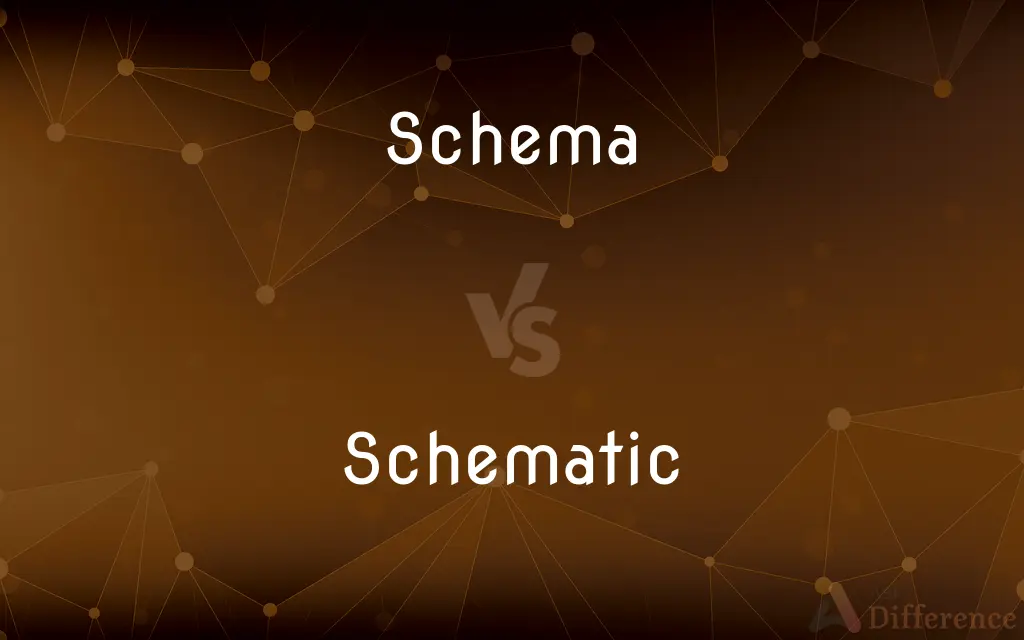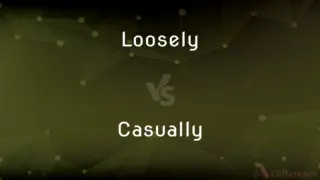Schema vs. Schematic — What's the Difference?
By Tayyaba Rehman & Urooj Arif — Updated on March 26, 2024
A schema outlines a framework or model, often abstract in nature, while a schematic provides a detailed plan or diagram, usually technical.

Difference Between Schema and Schematic
Table of Contents
ADVERTISEMENT
Key Differences
A schema is generally a conceptual framework that organizes information and provides a systematic structure for understanding complex ideas or systems. It can be applied in various fields such as databases, psychology, and data processing. Schematics, on the other hand, are detailed diagrams or drawings that represent the components of a system and their interconnections, commonly used in engineering and architecture.
While schemas are used to conceptualize and categorize information, aiding in the comprehension of broad concepts, schematics serve a more practical purpose by providing precise and technical descriptions of how components interact within a system. This makes schematics essential for the construction, repair, or troubleshooting of electronic circuits, mechanical systems, and software architecture.
Schemas often evolve as new information is integrated, allowing for a flexible and adaptable understanding of complex systems or theories. They are abstract and not tied to physical representations. Conversely, schematics are static representations, detailed and specific, designed to convey exact information about a particular system at a given point in time.
In the realm of databases, a schema refers to the organization of data as a blueprint of how the database is constructed, detailing the relationships among data points. In contrast, a schematic in electronics would depict the arrangement of circuits and components, guiding the assembly or analysis of the device.
The interpretation of schemas is more subjective and can vary significantly across different individuals or disciplines, reflecting a high-level understanding or approach. Schematics require a technical understanding of specific symbols and conventions, aiming for a universal clarity in conveying detailed instructions or technical information.
ADVERTISEMENT
Comparison Chart
Definition
An abstract framework organizing information or concepts.
A detailed diagram or drawing showing components and connections.
Purpose
To provide a conceptual understanding or organization.
To illustrate detailed technical information or processes.
Application
Broad, used in fields like psychology, databases, and theories.
Technical, used in engineering, electronics, and architecture.
Flexibility
Flexible, evolves with new information.
Static, represents a system at a specific point in time.
Interpretation
Subjective, based on broad concepts.
Objective, requires understanding of specific symbols and conventions.
Compare with Definitions
Schema
In databases, a representation of the structure of data.
The database schema outlines the relationships between tables.
Schematic
Used in architecture to represent buildings or structures.
The architect’s schematic detailed the renovation plans.
Schema
An outline or diagram used to organize complex ideas.
We used a schema to map out the novel’s plot.
Schematic
A diagram that represents the elements of a system.
The engineer drew a schematic to explain the circuit design.
Schema
A theoretical model used in various scientific disciplines.
His schema of the process simplified complex interactions.
Schematic
In electronics, a drawing showing components and connections.
Soldering the parts according to the schematic ensures the device functions correctly.
Schema
In psychology, a mental structure for organizing and interpreting information.
Children develop schemas to categorize objects they encounter.
Schematic
A tool for understanding mechanical systems.
The mechanic referred to the schematic to repair the engine.
Schema
A structured framework or plan.
The research project was based on a detailed schema developed in the early stages.
Schematic
A graphical representation used in software design.
The software schematic helped visualize the application’s architecture.
Schema
A plan, outline, or model
A schema for prioritizing vaccinations.
A writer's schema for a novel.
Schematic
A schematic, or schematic diagram, is a representation of the elements of a system using abstract, graphic symbols rather than realistic pictures. A schematic usually omits all details that are not relevant to the key information the schematic is intended to convey, and may include oversimplified elements in order to make this essential meaning easier to grasp.
Schema
(Psychology) A pattern imposed on complex reality or experience to assist in explaining it, mediate perception, or guide response.
Schematic
Of, relating to, or in the form of a scheme or diagram.
Schema
An outline or image universally applicable to a general conception, under which it is likely to be presented to the mind (for example, a body schema).
Schematic
A structural or procedural diagram, especially of an electrical or mechanical system.
Schema
(databases) A formal description of the structure of a database: the names of the tables, the names of the columns of each table, and the data type and other attributes of each column.
Schematic
Represented too simply or in an overly formulaic way, reflecting a shallow or incomplete understanding of complex subject matter
Schema
(markup languages) A formal description of data, data types, and data file structures, such as XML schemas for XML files.
Schematic
Sketchy, incomplete
Schema
(logic) A formula in the metalanguage of an axiomatic system, in which one or more schematic variables appear, which stand for any term or subformula of the system, which may or may not be required to satisfy certain conditions.
Schematic
Relating to a schema
Schema
(Christianity) A monastic habit in the Greek Orthodox Church.
Schematic
A simplified line drawing used by scientists, engineers, technologists and others to illustrate a system at an abstract level. Schematic drawings often use standard symbols for clarity.
I'll have to study the schematics for the new integrated circuit before I can create a good layout.
Schema
An outline or image universally applicable to a general conception, under which it is likely to be presented to the mind; as, five dots in a line are a schema of the number five; a preceding and succeeding event are a schema of cause and effect.
Schematic
Of or pertaining to a scheme or a schema.
Schema
An internal representation of the world; an organization of concepts and actions that can be revised by new information about the world
Schematic
Diagram of an electrical or mechanical system
Schema
A schematic or preliminary plan
Schematic
Represented in simplified or symbolic form
Common Curiosities
In what fields are schematics commonly used?
Schematics are widely used in engineering, electronics, architecture, and mechanics to illustrate complex systems.
How do schemas and schematics differ in purpose?
Schemas organize and conceptualize information for theoretical understanding, whereas schematics provide precise technical details for practical application.
What is a schema?
A schema is an abstract framework or model that organizes concepts, information, or systems, facilitating understanding and categorization.
Can schematics be considered a type of schema?
Technically, schematics can be seen as a specific, detailed type of schema focused on the practical, technical layout of systems.
Why are schematics important in construction and manufacturing?
Schematics are crucial in these fields for accurately conveying the design, components, and connections necessary for building or assembling systems.
Can anyone create a schematic?
While technically anyone can create a schematic, it requires knowledge of the system being depicted and familiarity with the specific symbols and conventions used.
What role do schemas play in psychology?
In psychology, schemas are mental structures that help individuals organize and interpret information, influencing perception and understanding.
Are schematics used in software development?
Yes, schematics are used in software development to visually represent the architecture, components, and workflow of software systems.
What is a schematic?
A schematic is a detailed diagram or drawing that illustrates the components of a system and their connections, often used in technical fields.
Are schemas static or flexible?
Schemas are flexible and can evolve as new information is integrated, unlike schematics, which represent a fixed point in time.
How do schemas help in learning?
Schemas aid in learning by providing a structured way to organize and integrate new information into existing knowledge frameworks.
How do databases use schemas?
In databases, schemas define the structure of the database, including the tables, fields, relationships, and constraints, guiding how data is stored and interacted with.
How do architects use schematics?
Architects use schematics to present detailed plans and designs of buildings or structures, showing spatial relationships and construction details.
Is a schematic the same as a blueprint?
While similar, a schematic is generally less detailed than a blueprint, focusing on the arrangement of components rather than precise measurements and construction details.
Can a schema change over time?
Yes, a schema can change and adapt as new information is learned, reflecting a more dynamic understanding of concepts or systems.
Share Your Discovery

Previous Comparison
Loosely vs. Casually
Next Comparison
Shallow vs. NarrowAuthor Spotlight
Written by
Tayyaba RehmanTayyaba Rehman is a distinguished writer, currently serving as a primary contributor to askdifference.com. As a researcher in semantics and etymology, Tayyaba's passion for the complexity of languages and their distinctions has found a perfect home on the platform. Tayyaba delves into the intricacies of language, distinguishing between commonly confused words and phrases, thereby providing clarity for readers worldwide.
Co-written by
Urooj ArifUrooj is a skilled content writer at Ask Difference, known for her exceptional ability to simplify complex topics into engaging and informative content. With a passion for research and a flair for clear, concise writing, she consistently delivers articles that resonate with our diverse audience.















































